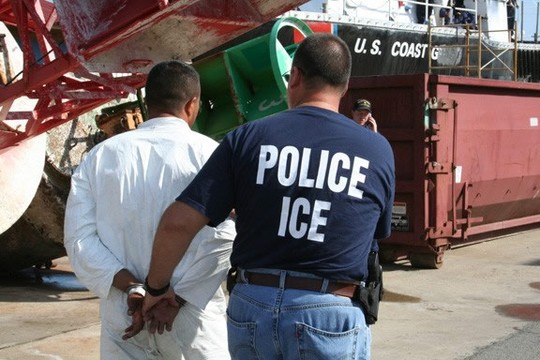
SAN FRANCISCO — Recent nets cast by Immigration and Customs
Enforcement (ICE) captured hundreds of undocumented immigrants at
worksites nationwide. In their wake, say immigrant rights advocates,
family members and attorneys for those arrested struggle to find their
loved ones and clients. As ICE expands, though, so will the
deportations, the so-called “golden measure” of its success.
On April 17, 311 immigrants were taken into custody at Pilgrim’s Pride
poultry plants in five states: Mount Pleasant, Texas; Live Oak, Fla.;
Chattanooga, Tenn.; Batesville, Ark.; Moorefield, W. Virg. The
Pilgrim’s Pride raids were the largest of 11 worksite raids conducted
by ICE agents that day.
The raids on worksites, along with the growing number of “fugitive
operations teams” that pursue individuals with removal orders and a
program that increases local police cooperation in immigration
enforcement, are “creating an incredible climate of fear,” says Andrea
Black, network coordinator of Detention Watch Network, a national
coalition of individuals and nearly 100 groups advocating humane reform
of the U.S. immigration detention and deportation system. Black and
Paromita Shah of the National Immigration Project of the National
Lawyers Guild spoke during Access Washington, a regular conference call
with immigration experts and ethnic media reporters convened by New
America Media.
The raids form part of “Operation Endgame,” ICE’s strategic plan for
“removing all removable aliens” by 2012. They come after years of
increased emphasis on enforcement of federal immigration law, according
to Black. “There has been a huge ramping up of resources to make this
happen.”
ICE is the second largest law enforcement agency in the country, Black
says. In FY 2007, her group reports, ICE made nearly 5,000 arrests as
part of its worksite enforcement program. That follows a seven-fold
increase in worksite arrests between 2002 and 2006. In addition,
activists report anecdotal evidence of arrests at bus and train
stations, DMV offices, and as a result of individual tips. ICE held an
average of 30,000 detainees per day last year at a cost of $1.2 million
dollars, or $95 per bed per day.
The methods of ICE in conducting raids and detainments came under fire
during the conference call with experts and ethnic media reporters on
Apr. 22.
Those detained in the raids are quickly transferred all over the
country, according to Shah of the National Immigration Project.
Families try in vain to locate their missing members, and, for
instance, “have much trouble trying to ensure heart medication reaches
their loved ones,” Shah recounts. It is difficult to satisfy medical
needs and shoulder the responsibilities, such as caring for the
elderly, of those detained.
She and other advocates tried to get information through the proper
channels, Shah says. “ICE has a hotline, but it hasn’t worked.
Information on family members could not be provided.”
A lack of bed space in detention centers explains most of the
transfers, says Andrea Black. But there have been some instances where
advocates and detainees claimed they were moved in retaliation for
their actions, she adds. When detainee Victoria Arellano died in
detention in San Pedro, Calif., due to a lack of medical care, fellow
detainees protested. ICE moved them to other centers so investigators
couldn’t get their reports on the death, Black says.
Shah identified other challenges posed by the detentions. For detainees
and their family to get correct legal information and representation is
not easy in the opaque ICE hearing process. In violation of the law,
Shah says, “People aren’t allowed to have counsel during this time when
immigration proceedings are allegedly practiced.”
Some employers are treated as partners in the raids, while others are arrested.
“(Immigration authorities) claim they’re going after employers,”
Detention Watch Network coordinator Black said. “They say, ‘We’re
trying to support workers’ rights, because when undocumented are
brought in, they’re exploited.’ But in many places ICE raids are
targeting employees.”
When 20 workers were taken on Apr. 11 from the Shipley D-Nuts plant in
Houston, ICE released no information regarding charges against
supervisors. Only in a series of strikes against a chain of Mexican
restaurants in western New York, Pennsylvania, West Virginia and Ohio,
where 45 immigrants were caught, were the owner of the chain and nine
of his managers apprehended.
In the Pilgrim’s Pride case, says Andrea Black, “The company fully
complied with ICE. I don’t know details of Mexican restaurants raids,
but they came at it from a different approach.”
ICE plans to grow. It currently has 75 “fugitive operations teams,” and
budget approval for another 29. It is requesting a budget increase of
95 million for FY 2009, which includes 1,000 additional detention beds.
But its mission remains the same. The “golden measure” of ICE’s
success, according to a 2003 statement by Anthony S. Tangeman, director
of the Office of Detention and Deportation, is the removal all
“aliens.”
About Reader Submission








